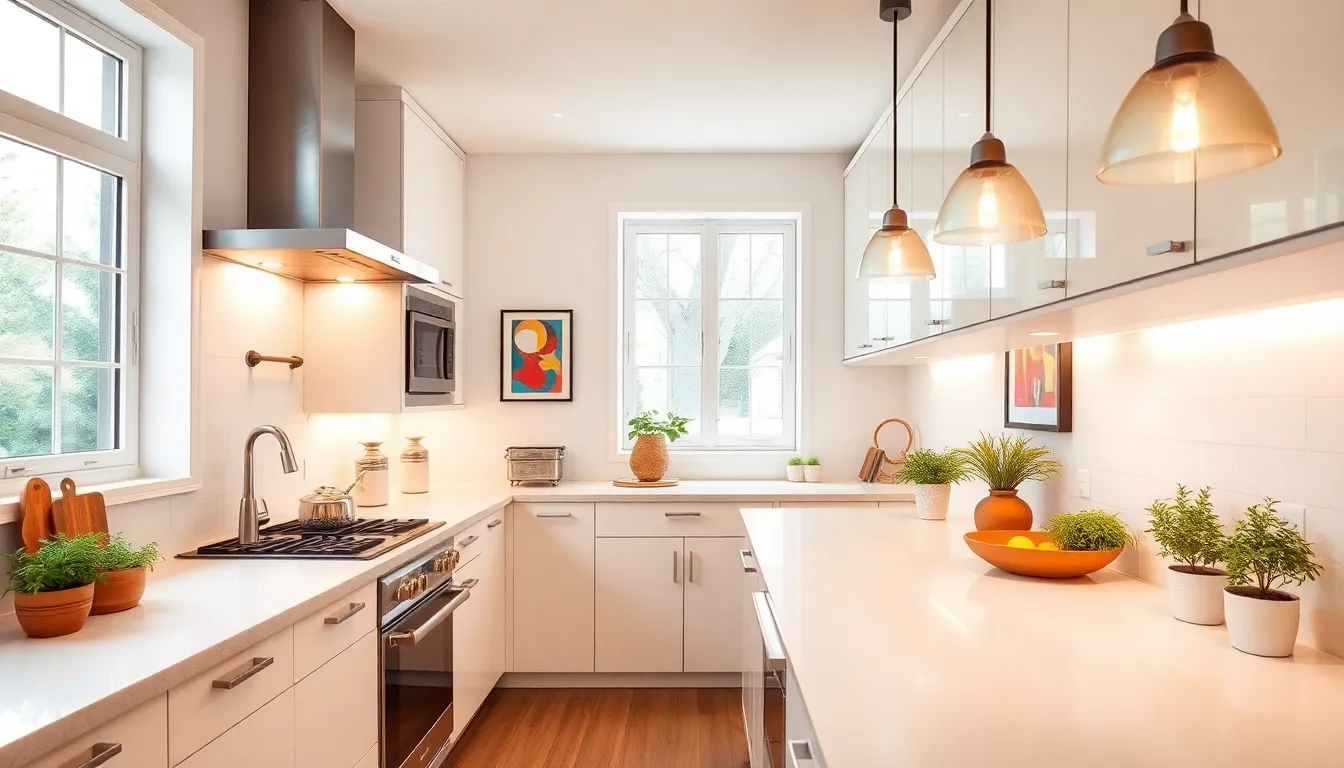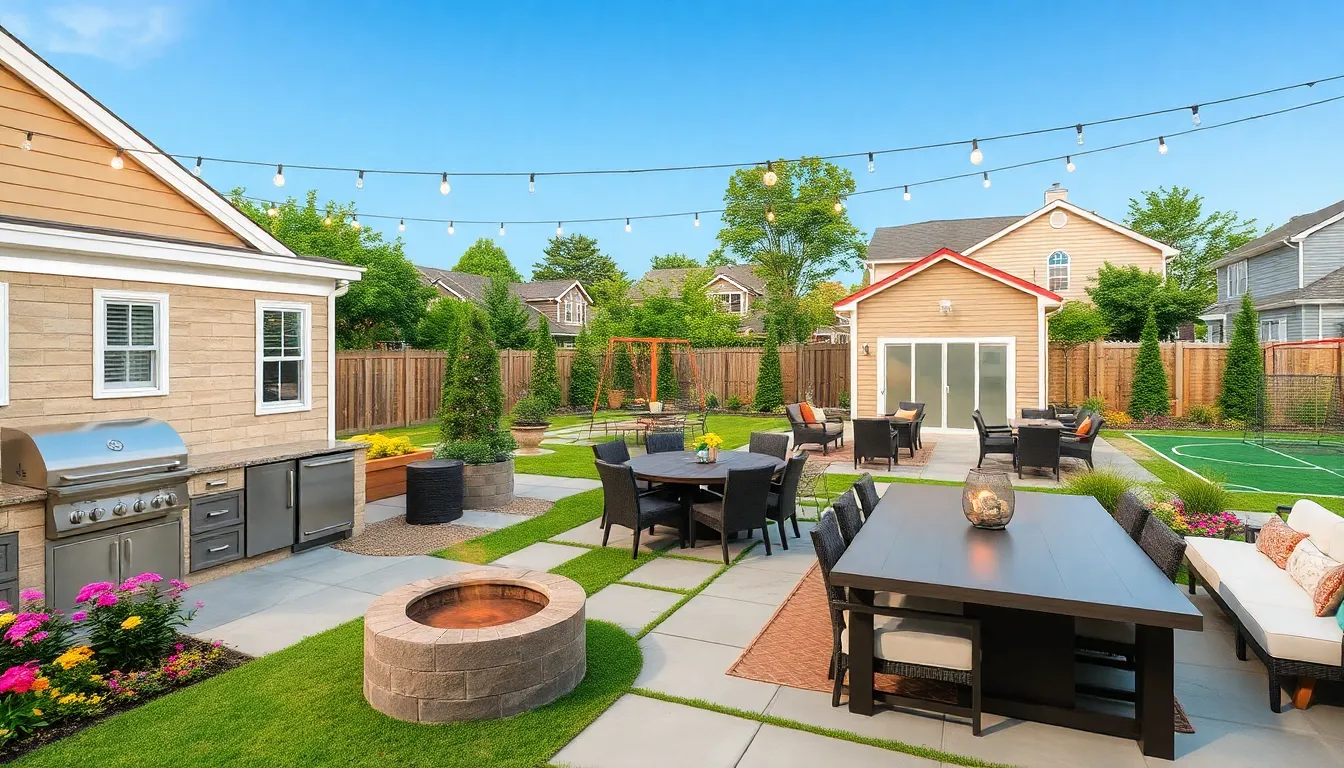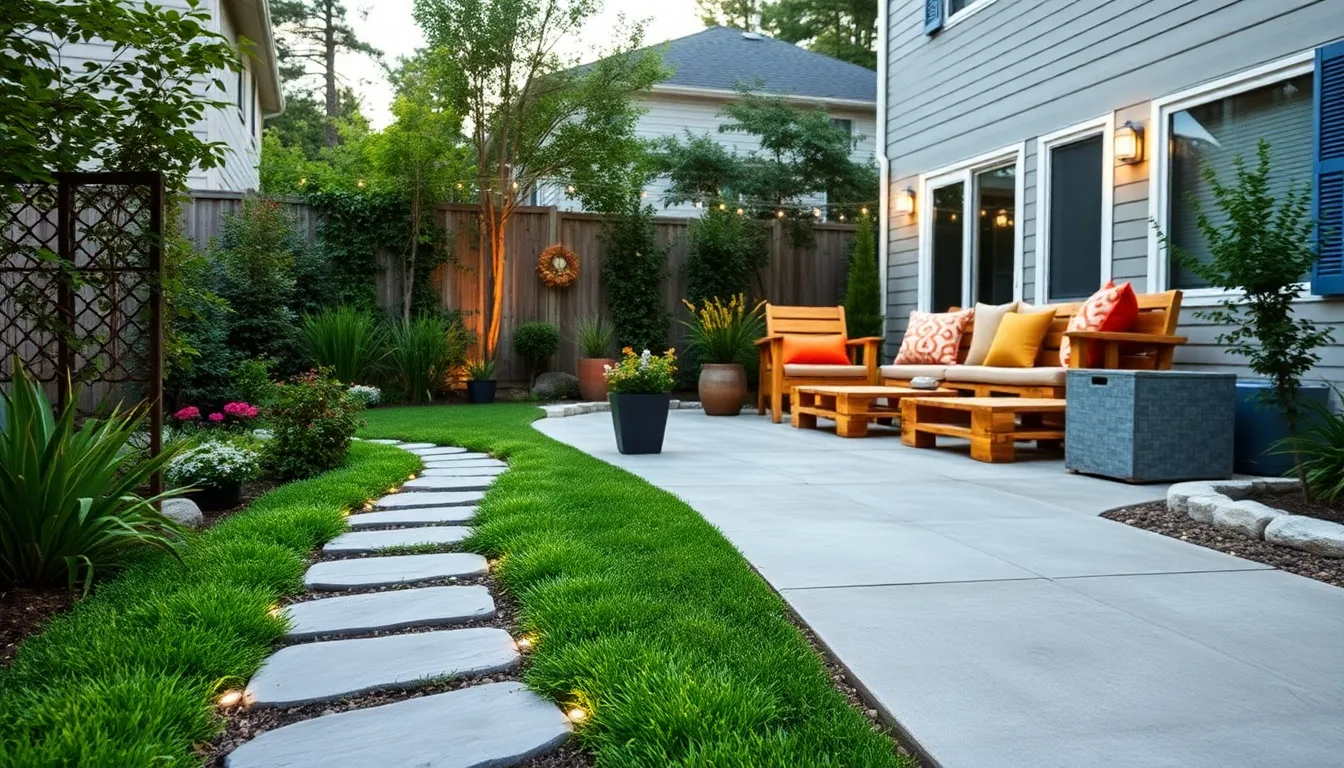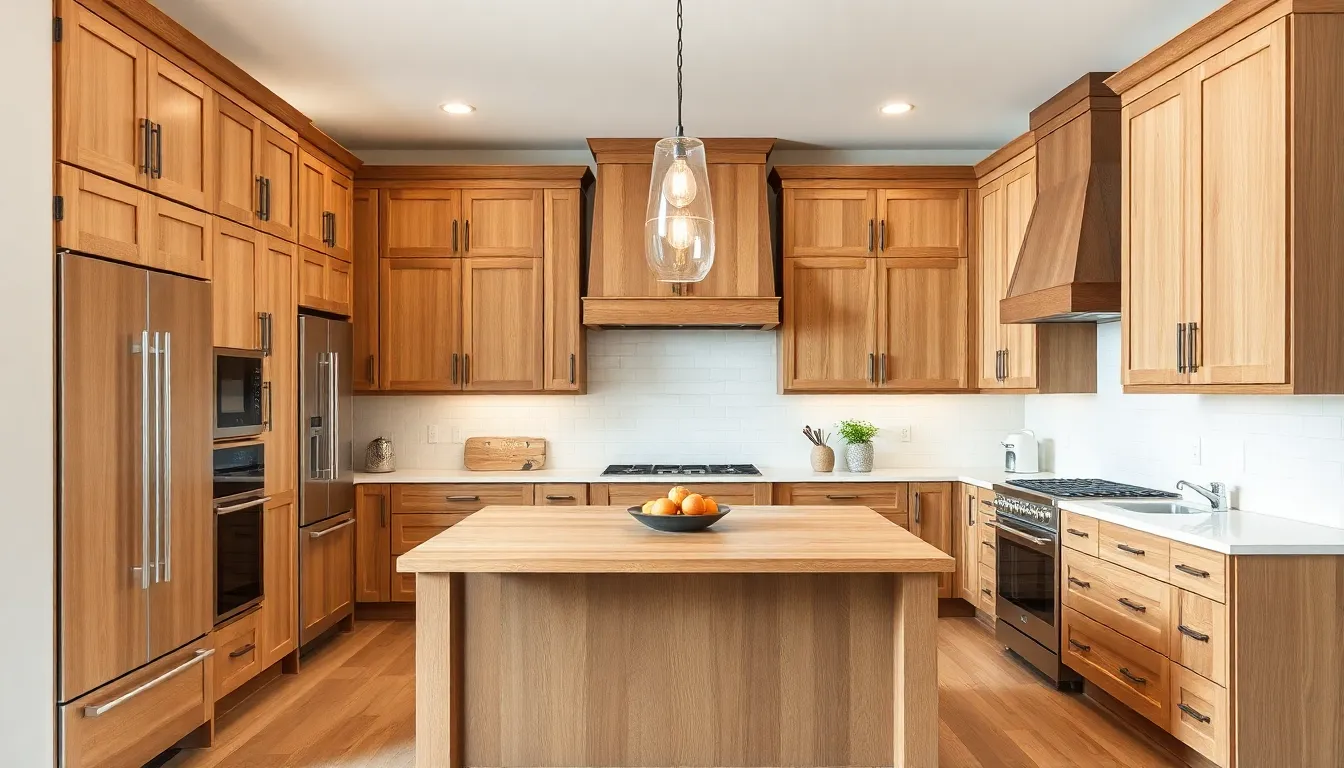Table of Contents
ToggleIn the world of kitchens, galley kitchens are the unsung heroes—efficient, compact, and often overlooked. But let’s face it, nothing says “culinary genius” like a well-lit galley kitchen. With the right lighting, these narrow spaces transform from cramped quarters into a vibrant hub of creativity. It’s like giving your kitchen a pair of stylish glasses—suddenly, everything’s clearer and a whole lot more inviting.
Overview of Galley Kitchen Lighting
Galley kitchen lighting plays a crucial role in creating a functional and inviting atmosphere. Proper illumination emphasizes the kitchen’s design and enhances its usability. Layered lighting solutions are essential for maximizing efficiency in narrow spaces.
Ambient lighting provides general illumination, filling the kitchen with soft light to ensure visibility throughout the area. This type of lighting often comes from ceiling fixtures, recessed lights, or pendant lights strategically positioned to minimize shadows.
Task lighting, on the other hand, focuses on specific work areas. Under-cabinet lights serve as a popular choice, brightening countertops for meal preparation and cooking. Using LED strip lights beneath cabinets offers a seamless look while ensuring that workspaces remain well-lit.
Accent lighting adds character and highlights decorative elements. Spotlights can draw attention to artwork or unique features in the galley kitchen. Incorporating pendant lights above islands or breakfast bars enhances aesthetic appeal and provides additional illumination.
Natural light also contributes to an inviting atmosphere. If windows are present, sheer curtains or blinds can maximize daylight while maintaining privacy. Combining both natural and artificial lighting ensures that galley kitchens feel spacious and welcoming.
Considering energy efficiency when selecting fixtures can significantly reduce utility costs. LED bulbs not only consume less electricity but also have longer lifespans compared to traditional bulbs. Installing dimmer switches allows for control over light intensity, providing flexibility for various activities.
Galley kitchen lighting encompasses ambient, task, accent, and natural light solutions. Utilizing a combination of these options fosters an efficient and visually appealing environment ideal for culinary activities.
Importance of Proper Lighting
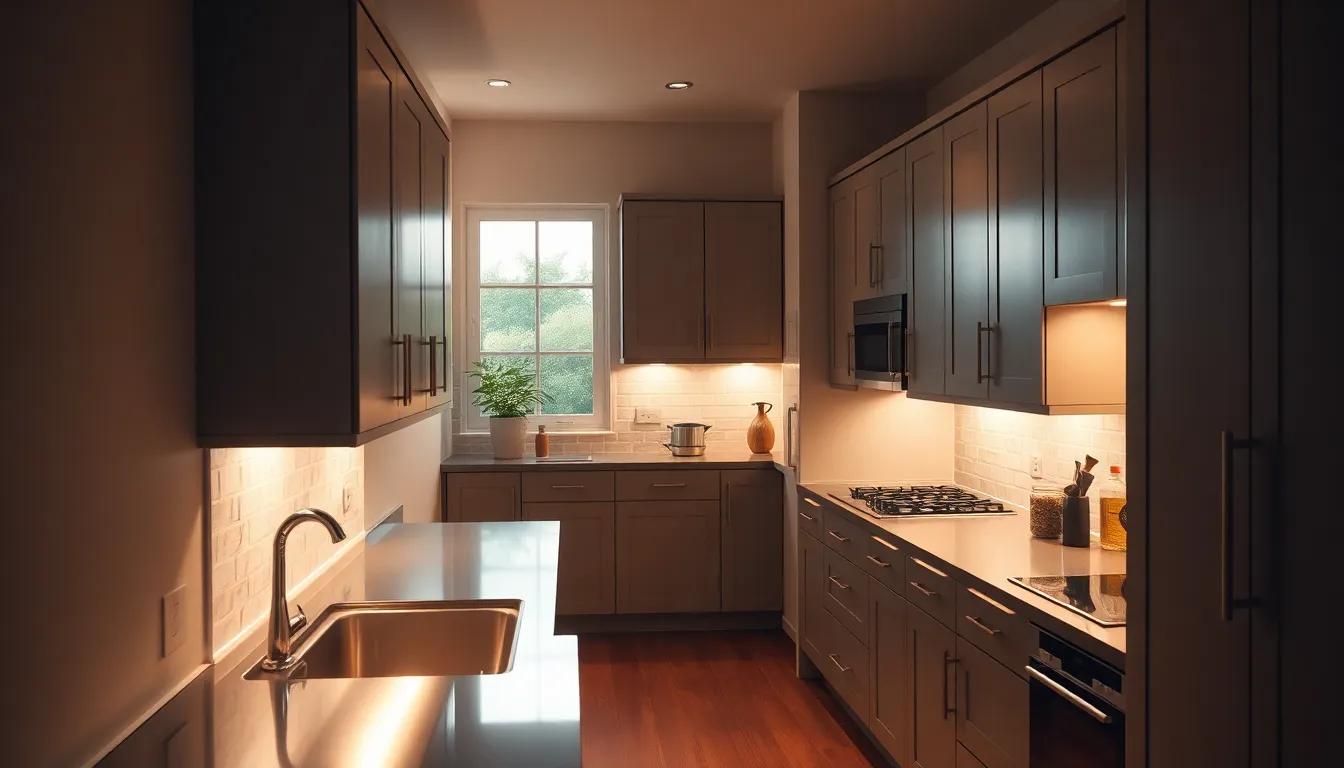
Proper lighting enhances the overall experience in a galley kitchen. It significantly impacts both functionality and ambiance.
Enhancing Functionality
Functional lighting caters to specific tasks performed in the kitchen. Effective task lighting illuminates countertops and work areas, ensuring safety and efficiency while cooking. Adjustable fixtures, such as under-cabinet lights, target critical spots for meal prep. Illuminating these spaces encourages productivity, especially during busy cooking sessions. Additionally, bright overhead fixtures provide general visibility throughout the kitchen, allowing for seamless navigation in smaller areas. Energy-efficient options, like LED bulbs, ensure these lights remain cost-effective while fulfilling their vital role.
Creating Ambiance
Ambient lighting plays a crucial role in setting the kitchen’s atmosphere. Soft, warm lights create an inviting environment ideal for gathering and enjoying meals. Strategically placed accent lights highlight design features, adding visual interest to the narrow layout. Natural light further enhances this ambiance, making the kitchen feel more spacious and welcoming. Dimmer switches allow users to adjust brightness levels based on mood and occasion, adding versatility. Combining these elements transforms the kitchen into a lively space perfect for creativity and culinary exploration.
Types of Lighting for Galley Kitchens
Selecting the right lighting enhances the functionality and aesthetics of galley kitchens. Emphasizing a layered approach allows for more effective use of space.
Task Lighting
Task lighting provides focused illumination for specific areas where cooking and food prep occur. Under-cabinet lights excel at illuminating countertops while minimizing shadows. Pendant lights over the island or work surfaces also add brightness. Recessed lighting effectively targets work zones, offering a sleek look. Adjustable fixtures allow users to direct light exactly where it’s needed, improving safety while cooking.
Ambient Lighting
Ambient lighting creates a warm and inviting atmosphere, essential for social gatherings. Ceiling-mounted fixtures provide general illumination, ensuring the entire space feels balanced. Choose dimmable options to adjust brightness levels based on the occasion. Natural light should be embraced through strategically placed windows or skylights. Using lighter colors for walls helps reflect light, amplifying brightness.
Accent Lighting
Accent lighting adds visual interest by highlighting decorative elements and architectural features. Wall sconces can frame artwork or open shelving, drawing attention to unique aspects of the kitchen. LED strip lights enhance the allure of cabinets or above shelves, creating a warm glow. Pendant lights can also serve as statement pieces, adding both function and style. Thoughtfully placed accent lighting elevates the kitchen’s overall ambiance, contributing to a cohesive design.
Tips for Choosing Galley Kitchen Lighting
Choosing the right lighting enhances the functionality and aesthetics of a galley kitchen. Effective lighting solutions contribute significantly to the overall atmosphere.
Fixture Styles
Stylish fixtures add character to a galley kitchen. Pendant lights work well above countertops or islands, providing focused illumination. Wall-mounted sconces can also enhance brightness while saving counter space. Recessed lighting offers a streamlined look, blending seamlessly with the ceiling. Combining different styles optimizes both task and ambient lighting throughout the kitchen.
Bulb Types
Selecting the right bulbs impacts both efficiency and ambiance. LED bulbs are energy-efficient and long-lasting, making them a popular choice. Brightness levels are crucial; bulbs with a Kelvin rating of 2700K to 3000K create a warm atmosphere. For task areas, consider higher-lumen bulbs to ensure adequate lighting during food preparation. Dimmable bulbs offer versatility, allowing users to adjust brightness for different occasions. Using a mix of bulb types enhances depth and functionality in a galley kitchen.
Common Mistakes to Avoid
Neglecting a layered lighting approach often results in insufficient illumination for a galley kitchen. A single source of light might create shadows in work areas, making tasks challenging. Choosing overly bright lighting can cause glare, which detracts from the kitchen’s overall comfort.
Positioning all fixtures in the center of the room can limit effective illumination. Placing under-cabinet lights too high reduces their effectiveness, leaving countertops poorly lit. Ignoring the importance of dimmers can undermine the kitchen’s atmosphere, preventing flexibility in brightness for different tasks or moods.
Failing to consider scale when selecting fixtures can lead to overwhelming or underwhelming aesthetics. Large pendant lights in a narrow galley kitchen may crowd the space, while tiny fixtures might go unnoticed. Additionally, overlooking natural light sources limits the overall brightness and openness of the kitchen.
Forgetting to use accent lighting can hinder the visual appeal of the kitchen. Highlighting artwork or decorative shelves can create an inviting environment. Prioritizing energy-efficient bulbs, like LEDs, often gets overlooked, resulting in higher energy costs in the long run.
Neglecting to plan for maintenance can make future adjustments difficult. Ensure fixtures are easily accessible for cleaning and bulb replacement. Lastly, skipping compatibility checks between fixtures and existing electrical wiring can lead to installation issues, causing inconveniences and additional expenses.
Galley kitchen lighting plays a pivotal role in enhancing both functionality and aesthetics. With the right combination of ambient, task, and accent lighting, these compact spaces can become vibrant hubs for culinary creativity.
Choosing energy-efficient options and incorporating natural light can make a significant difference in the overall atmosphere. By avoiding common pitfalls and focusing on a layered approach, anyone can transform their galley kitchen into an inviting and efficient environment.
Ultimately, thoughtful lighting choices not only elevate the kitchen’s usability but also create a warm atmosphere perfect for gatherings. Embracing these strategies ensures that every meal prepared in a galley kitchen is accompanied by the perfect ambiance.

